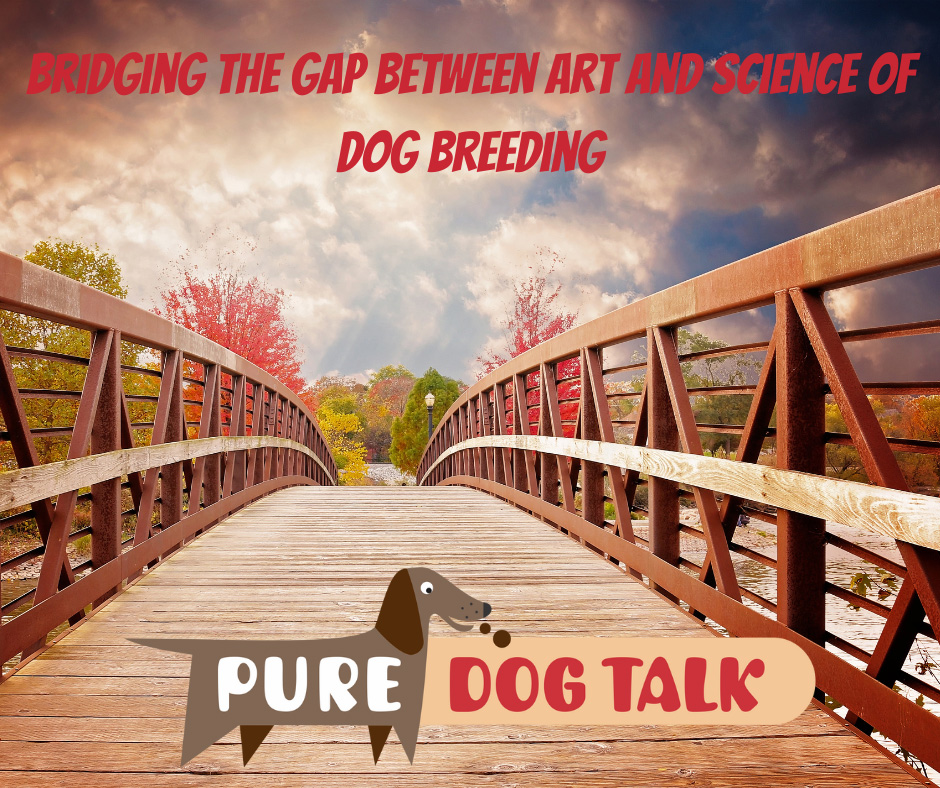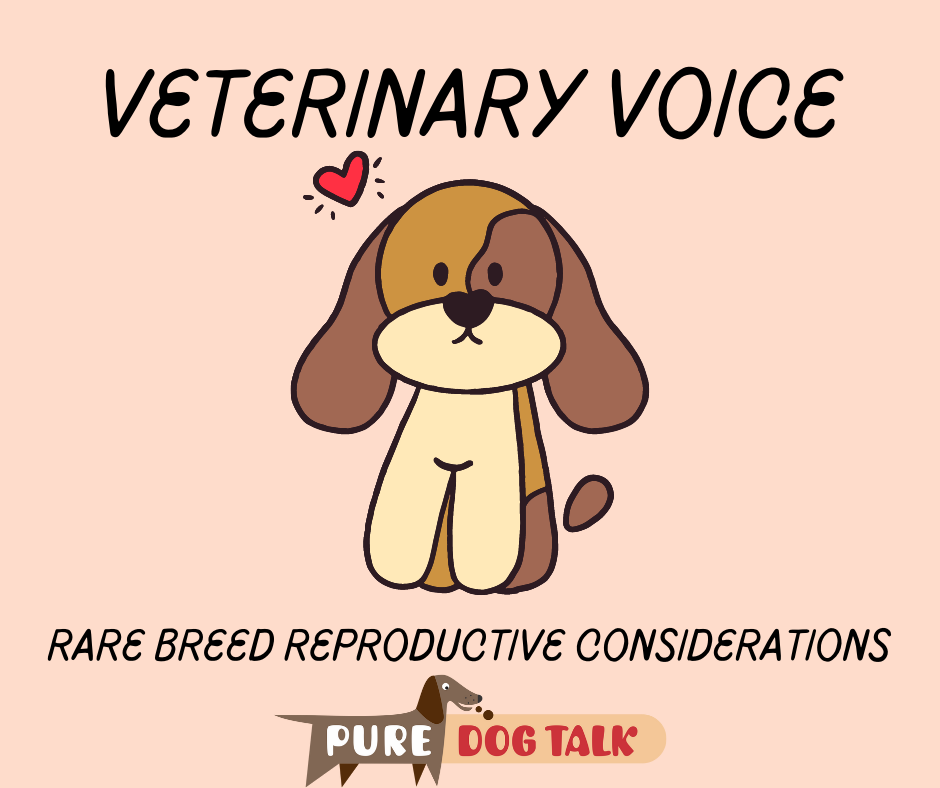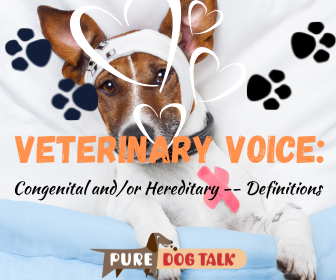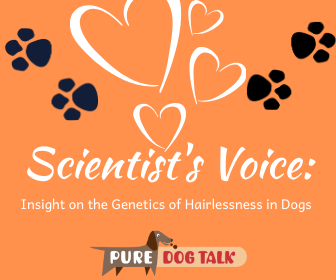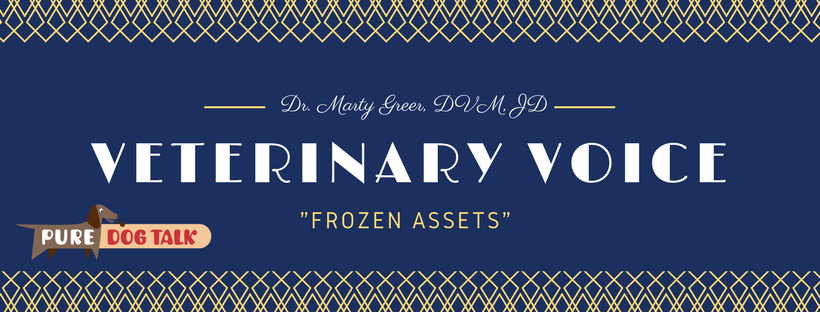651 – Bridging the Gap Between Art and Science of Dog Breeding
Bridging the Gap Between Art and Science of Dog Breeding
Host Laura Reeves is joined by Aimee Llewellyn Zaidi, project manager for the International Partnership for Dogs. Llewellyn Zaidi’s work is bridging the gap between art and science in dog breeding. They talk about inbreeding and genetic diversity, how those things go together and what you can do when there isn’t a test for a health problem.
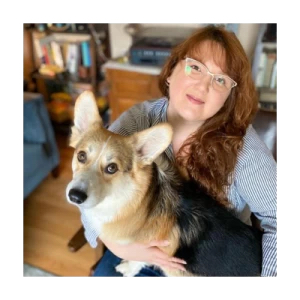
Aimée Llewellyn-Zaidi and her Corgi.
“International Partnership for Dogs offers free resources for dog breeders and for vets to kind of give you some unbiased transparent guidance,” Llewellyn Zaidi said.
“I am a third generation Pembroke Welsh Corgi owner. My grandparents had beef cattle in Oregon in the 1960s. They started their farm up in Silverton, Oregon. And my grandmother was a little bit of an Anglophile. And so she got two corgis back in the 70s in Oregon, which there weren’t too many corgis out here then.
“And she had these great aspirations of having them being working corgis and they worked really hard at cuddling. And they maybe, you know, barked at things, but yeah, they started as working dogs but were 100 % professional lap dogs, you know, as corgis really know how to do it. And I just never lost my love for the Pems.
“I started working as a health manager for the Kennel Club in the UK (in 2012). And by the end of my time in the UK, I had developed a team and I was the head of health and research there, really focused on bringing evidence-based education resources to breeders and to the veterinary community and to breed advisors with lots and lots of tools and resources available.
“I really wanted to take the science and kind of translate it into something practical. There wasn’t a lot of in between at the time between researchers and the people who actually have to make the breeding decisions and that disconnect really bugged me. I think it really bugged me that there wasn’t such an easy way for communication between really the art and the science of dog breeding, trying to bring those things a little bit closer together.
“I want to take some of the mystery out of some of science or some of the resources that are available. I try to be really honest and transparent about what we know, what we don’t know, what’s still kind of out there, what things might be not the most ideal resources.
“I feel like that honesty is the best way for people to be informed and to make ultimately the breeding decisions. You guys have the hard job. You have the job of deciding, right? So, I just want to give you information that can help you hopefully make those really informed decisions.”
523 – Special Reproductive Considerations for Rare Breeds
Special Reproductive Considerations for Rare Breeds
Dr. Marty Greer, DVM joins host Laura Reeves to discuss some of the special reproductive considerations for rare breeds. Rare dog breeds offer specific challenges for their breeders including health concerns, limited gene pools, DNA testing mazes and infertility issues.
April is Rare Breeds month here at Pure Dog Talk! Watch for upcoming episodes with deep dives into Norrbottenspets, Chinooks and Nederlandse Kooikerhondje.
“Pick one thing a year that you’re going to try to work through in your breed,” Greer said, quoting from Dr. Ian Dunbar. “Pick what your priorities are. You have to pick. I can’t pick for you. You know your breed. You know your genes. At some point we have to really say this is what I’m going to focus on, this is what I’m going to try to breed for or away from, and try to take those incremental steps. You’re not gonna get it all in one generation.”
How do you eat an elephant…
“I think that’s so important in the rare breed community to emphasize the you eat the elephant one bite at a time,” Reeves added. “It’s really important to recognize that and not get discouraged because you’re trying to swallow a whole elephant. Be committed to that long term process. From a rare breed perspective, that’s one of the things I always emphasize, this is not a fly by night operation. It’s a process, something you’re going to dedicate your entire life to.”
“You work with other people and you’re honest with other people,” Greer emphasized. “So we need to stop hiding things. We need to stop backbiting. We need to stop saying bad things about other people and we need to be really honest with each other and with ourselves so that when you look in the mirror you can say ‘I’m breeding the best dog that I possibly can.’
Full disclosure
“Nobody goes out and deliberately breeds a bad dog but there’s so many aspects to how you have to make these decisions. Without full disclosure you really can’t get there. So we have to be honest with each other. No breeder deliberately produced a dog with a genetic problem, but you’ve got to tell people if you have it because if you double up on it you’re going to have surprises in your litter.
“Longevity, I think, is seriously under-appreciated. I love breeding females that can still have puppies when they’re older. I love breeding old males that still produce sperm. Now that doesn’t mean you can’t freeze semen when he’s young, and you should because then you’ll have access to him, but if he lives to be 16 years old and he was fertile till he was 14, you rock man! That means he didn’t die of orthopedic disease, he didn’t die of bad temperament, he didn’t die because he ran away from home and got hit by a car. He didn’t die from 1,000 things that he could have died from.
Longevity for the win
“Don’t forget about those old guys and their genetics. Go back to the old publications of your breed. Go back to the old pedigrees and take a look and where are those dogs and what are they doing and how long did they live and what was their lifestyle like and what did they die from.”
Greer also strongly recommends purchasing Dr. Jerold Bell, DVM’s book for learning more information on genetic diseases in specific breeds.
488 – Veterinary Voice: Congenital and/or Hereditary Definitions
Veterinary Voice: Congenital and/or Hereditary Definitions
Dr. Marty Greer, DVM joins host Laura Reeves for a deep dive on the question of congenital vs hereditary disease definitions.
“So congenital is something you’re born with, not necessarily inherited, but something you’re born with. Genetic is something that you carry the DNA for,” Greer said. “If you’re born with something, it’s congenital. So, if you’re born with the umbilical cord wrapped around the puppies leg and the leg doesn’t fully develop, that’s congenital because they were born with it but it wasn’t genetic, it was an accident that the cord wrapped around the way. Just ’cause you see it at birth doesn’t mean it’s genetic.
Many diseases, Greer noted, “there is a genetic basis” with a “trigger.”
“An epigenetic or an environmental trigger, is there a nutritional component to it, was there some exposure to a chemical that predisposed the patient to it. So that’s where it starts to get muddy. Not everything that’s genetic is easy to figure out the inheritance pattern for. The things that we can DNA test for now are pretty much autosomal recessive genes,” Greer said.
“Are we throwing dogs out of our gene pool because they have something that’s genetic and we don’t have the right test for it, then we may never have a test for it or it’s not genetic or have some genetic and epigenetic and environmental component to it? As much as we think we understand this stuff, it’s not easy,” Greer added.
“The more we know, the less we know. As we start adding this information to our knowledge base, it’s going to become evident to us that what we thought isn’t really true… all information is valuable, but if you don’t apply it correctly, you’re going to end up bottlenecking your gene pool, as you’re going to throw good dogs out.”
402 – Insight on the Genetics of Hairlessness in Dogs
Insight on the Genetics of Hairlessness in Dogs
Adam Boyko, Chief science officer and co-founder of Embark, joins host Laura Reeves to talk about the Fox I3 gene, that causes hairlessness in many dog breeds.
“So it’s a gene that’s gonna be involved in what we would call ecto dermal differentiation,” Boyko said. “So it’s going to affect a lot of tissues that are in the ectoderm. Not just hair follicle formation but also things like the inner ear or the sweat glands or dentition. All of these things that are related because they’re coming from the same developmental tissue.”
“The canine genome was first sequenced in 2005, so we have a reference genome now from Tasha the boxer and this was a big $25,000,000 project,” Boyko noted.
“(Some of) my colleagues worked on it. This was before I got into dog genetics. I was graduating from Purdue with a degree in biology but I was studying butterflies at the time. So I didn’t join the dog field until after we had a genome. I switched because there’s so much more cool stuff you can do with an organism that has a genome and particularly with dogs.
“In 2008 (researchers) were able to identify the gene that’s different between dogs that are hairless and dogs that aren’t. This Fox I3 gene. The mutation itself is just this insertion of seven base pairs. Remember, the genome is like 2 1/2 billion base pairs. So that little mutation then is the difference between whether the dog has hair or doesn’t.
“One of the projects I started out with … we call the village dog project. Most of the dogs in the world aren’t purebred dogs and they’re not even mixed breed dogs the way you and I think of mixed breed dogs. They’re actually natural populations of dogs that have been around for thousands of years and probably have some really interesting biology. If you look at village dogs across the new world, you do occasionally come across dogs that carry this mutation and have the hairless phenotype. If you look at dogs that have a very, very similar sequence, so that the same genetic background but don’t have the mutation, these are the closest relatives for where the mutation occurred for dogs that don’t have the mutation. It’s actually like Alaskan Huskies and other northern dogs that are very puffy, puffy dogs, but they have DNA still in them that pre-Columbian Native American dogs had.
“Genetically you get the signature that this is a mutation that arose in the new world before European contact and this is the basis for Mexican hairlessness right so the Xolo, the Peruvian Inca Orchids, as well as the Chinese Crested.
Two copies is deadly
“This mutation is actually lethal. A dog with two copies of the mutation dies in utero. So, every hairless dog has one copy of the broken Fox I3 gene and one good copy of the Fox I3 gene.
“The “powder puff” have better dentition. This Fox I3 mutation not only effects the development of hair follicles and interrupts them throughout most of the body, but the dentition is also affected. The teeth, both the deciduous teeth and the permanent teeth, generally you don’t see as many developed, they’re not as well formed, they tend to be more conical, they’re a little more tusk like, they point out a bit more. These are all kind of developmental defects. The powder puff doesn’t have these defects, not because it has a better Fox I3 gene that you want to breed in, it just doesn’t have the broken one.”
Evolutionary purpose of hairless dogs
“I think ultimately the purpose is that people really like unique and distinctive dogs,” Boyko said. “You have this mutation which has a dominant effect, so as soon as it arose that dog was hairless. And it arose in an environment where people thought that this was a sacred dog or a dog that they wanted to have around.”
From XCA:
“A uniquely New World breed, the Xoloitzcuintli stands out for being hairless, although there is a coated variety. The Xoloitzcuintli was one of the earliest breeds to be added to the American Kennel Club studbook – in 1887 under the name “Mexican Hairless”. This is a robust and healthy breed that evolved in the primitive jungles of Colima, Mexico. Archaeological evidence has been found in the tombs of the Colima, Mayan, Toltec, Zapoteca, and Aztec Indians dating the breed to over 3500 years ago. Long regarded as guardians and protectors, the indigenous peoples believed that the Xolo would safeguard the home from evil spirits as well as intruders. In ancient times the Xolos were often sacrificed and then buried with their owners to act as guide to the soul on its journey to the underworld. These dogs were considered a great delicacy, and were consumed for sacrificial ceremonies – including marriages and funerals.
The name Xoloitzcuintli (pronounced “sho-low-itz-queent-li”) is derived from the name of the Aztec god Xolotl and Itzcuintli, the Aztec word for dog. (Xolo owners are frequently stopped and find themselves explaining not just the breed – but teaching people how to pronounce the name!) Indigenous peoples believed them to have healing powers and they were thought to bring relief from a vast variety of ailments. That belief still survives today in the rural parts of Mexico. One of the reasons being that they feel warm to the touch – and can actually act as a “hot water bottle”.”
“Gene mutations happen accidentally,” Boyko said. “They happen randomly. Then they are perpetuated because they serve a purpose evolutionarily. Because dogs are domesticated and people can selectively breed them and selectively protect them and provision them, you’ll get mutations like this that really would disappear rather quickly if it happened in a wild population. If you had a hairless Wolf that didn’t have good teeth, it wouldn’t last long. It’s not going to survive to adulthood and reproduce.”
Be sure to check back next week for our conversation with Xolo breeders and enthusiasts.
357 – Genetic Testing Helps You Swipe Right for Your Dog
Genetic Testing Helps You Swipe Right for Your Dog
Today’s dog breeders are getting a boost from the burgeoning field of genetic testing. Doberman Diversity Project co-founder Sophie Liu talks about her work using advanced tools to improve genetic health issues in Doberman Pinschers.
Liu was a vet student researching her next dog when she became aware of the multitude of health challenges facing Dobermans.
According to the DDP website:
OUR MISSION is to reduce the incidence of heritable diseases in the Doberman by studying and addressing the depression in the overall genetic diversity of the Doberman breed and studying and researching widespread disease-associated mutations, through comprehensive genetic testing and analysis, development and sharing of evidence-based breeding findings, development of online breeder decision-making tools, and long-term tracking of results to measure the effectiveness of varied approaches to breeding — in terms of genetic health and longevity.
Combatting DCM
Liu said that a major focus of their research is geared toward reducing the incidence of Dilated Cardiomyopathy in the breed, which currently is plagued by the devastating disease, with nearly half of the breed being affected.
A great deal of DDP’s research and studies are directed at developing a tool which establishes a genetic value for the risk of passing on DCM. Building on the work done by Guide Dogs for the Blind, DDP hopes to enable breeders to determine an “estimated breeding value” for DCM on a pedigree and genetic basis.
“This is a super powerful tool,” Liu said. “This is how guide dogs have systematically improved their breeding program.”
The two genes identified to date that are associated with DCM in Dobermans are autosomal dominant, Liu said. Because the disease shows up late in a dog’s life, it can be hard to stay ahead of, she noted.
Genetic testing offered through Embark at cost enables DDP to track genetic data. Study participants also update all clinical health data for the research project.
Need more dogs tested
Liu said that in just about two years DDP has tested more than 2,500 dogs, but they need many more.
“We need more dogs tested. Affected and unaffected dogs. We need raw data and clinical updates and medical records,” Liu said. The guide dog programs’ success relies on having the advantage of huge breeding colonies that are all tested in house, she added.
DDP’s relationship with Embark enables breeders to find the right balance between the inbreeding percentages needed to fix type and maintain health. Embark’s breeder tool enables people to make that decision for themselves, Liu noted, “just like Tinder for your Doberman.”
“We’re finding out that the genetic bottlenecks are worse than we thought,” Liu noted. “Over 99% of Dobermans share a single paternal haplotype, in other words, one stud dog is behind nearly every Doberman tested.”
The research is also turning up valuable information about the heritability of various traits – in other words, how much variation of the trait is genetic. For example, studies indicate 40 percent of fear behavior is genetic. For more on the topic of how genetics impact fear behavior, listen to Pure Dog Talk Episode 221.
“People go to breeders for consistency,” Liu said. “The better we get at it, the better it is for everyone.”
211 – Dwarfism: When the Right Gene Goes Wrong
The Dark Side of the Dwarf Gene
Dr. Theresa Nesbitt talked last week about the purpose-bred dogs that evolved with short legs to do very specific jobs. Today she talks about “the dark side of the dwarf gene” and what happens when things go wrong when you’re trying to do it right.
Dwarf genes have been around for more than 4000 years, Nesbitt said. They are solidly entrenched in some breeds that are specifically “fit for function” for the job they were meant to do.
“Everything that isn’t normal, isn’t pathological,” Nesbitt said.
Too much of a good thing
Sometimes, though, breeders can get “too much of a good thing,” Nesbitt added. She also shared tremendous information on the various genetic disorders of dogs who aren’t supposed to be dwarfs.
Nesbitt provided layman’s translation for a lot of medical terminology. She helped decipher topics like retro genes, epigenetics, genes that inadvertently land on the wrong chromosome and more.
Making words like achondroplasia make sense to those of us without a medical degree is a gift that Nesbitt shared throughout this episode. “Chondro,” for example, refers to cartilage, Nesbitt said, and “plasia” means growth. The dwarfism gene affects the rate at which animals (including humans) produce cartilage.
“The growth plate at the end of the long bones is like a disc of cartilage that keeps making longer bone,” Nesbitt said. “It pushes out like a pasta machine extruding bone in a perfect column.”
Genes are a “recipe book”
Nesbitt’s discussion of “layering genes,” autosomal recessive genes and the progress being made in the research community as they acquire more advanced understanding of how all of these systems work is fascinating. She also brought to the discussion ways in which research on canine genetics is benefitting people.
Intervertebral disc disease, in which calcification develops between the discs, is an area Nesbitt said research is making tremendous strides in identifying the specific genes responsible.
Genes provide a “recipe book” to the cells, for which epigenetics are the “family notes,” Nesbitt said. She added that the environment can change or modify genetics.
This is a “must listen” episode. And probably more than once! Nesbitt’s enthusiasm for the topic and ability to translate into layman’s terms is invaluable.
180 – Veterinary Voice: Dr. Marty Greer Talks “Frozen Assets”
Dr. Marty Greer Talks “Frozen Assets”
Frozen semen is an investment not only in one family of dogs, but in the future of the breed in question. Dr. Marty Greer, DVM, JD takes us through a checklist of important considerations for preserving genetic material from our best dogs.
First, Greer said, be sure the semen is stored in a safe facility. Sometimes even storing the same dog’s semen in more than one facility is worth the cost.
Greer’s story about a private semen storage whose owner passed away without a will in place is a cautionary tale.
Insure the Future with Frozen Semen
Second, make provisions for transfer of semen ownership, whether in a will or trust, Greer said. This vital step will ensure the safety of valuable genetics.
“Don’t look at it as your dog line’s future,” Greer said, “but take a step back and look at it as the future of your breed.”
She contends the value of frozen semen is that the best dogs are what we have in frozen. Improvement in testing for diseases means we can use genetic material even if it is imperfect, by using DNA testing to line up the frozen semen with an appropriate bitch.
“If we can test their semen … they’ve got preserved,” Greer said “and use those to match with the appropriate bitches, we can really move our breeds forward, if we’re willing to think hard about this and not just be looking at that little tiny bit of your genetic material but look at your breed as a whole …”
Greer is a strong advocate for planning ahead for the transferal of frozen semen ownership. And to consider sharing it outside one’s own breeding program.
“And in our semen freezing contracts we have a provision made for how that semen should be transferred,” Greer said. “You should have it in your will. You should talk to your attorney about it and a lot of attorneys are going to be unfamiliar with this kind of transaction. So you’re probably going to want to talk to somebody that has some expertise. Somebody in a legal position that they’ve either got a dog ownership and they’re attorneys as well. Debra Hamilton does a lot of work with trust for dogs.”
Another point Greer makes is acquiring insurance for the storage of the semen.
“ I have a few clients that have purchased old semen from their mentors,” Greer said “and they may have 10 to 20 dogs frozen and so they may have a good deal of financial investment in that. … insurance is available through a small number of companies but don’t count on it being insured at the place that you’re storing it.”
Greer also provides input on how to estimate fair charges for owners who will sell vials of frozen semen to other breeders.
Listen today for all of Greer’s great advice.
And if you missed it, you can listen to our interview last summer with Debra Hamilton on the topic of creating plans for the future of your dogs, breeding program and more at this link: https://puredogtalk.com/96-divorce-disease-disaster-disability-delay-death-and-your-dogs-debra-hamilton-esq-how-to-make-a-maap-plan-2/

